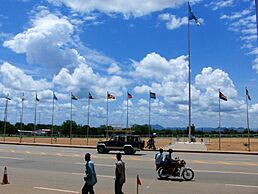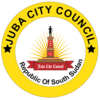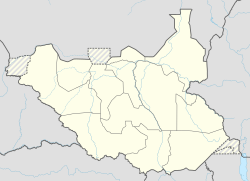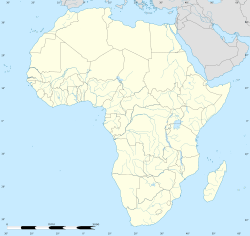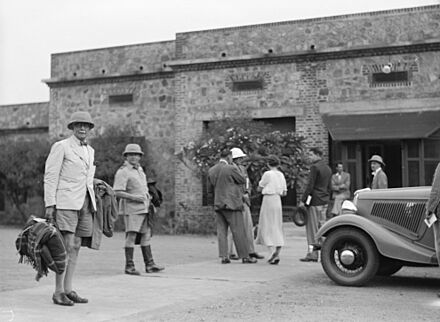Juba facts for kids
Quick facts for kids
Juba
|
|||
|---|---|---|---|
|
From top, left to right:
View of Juba, John Garang Mausoleum Square, aerial view, United Nations (UTair) Boeing 737, White Nile river in Juba |
|||
|
|||
| Country | |||
| State | Central Equatoria | ||
| County | Juba | ||
| Payam | Juba | ||
| Founded | 1922 | ||
| Government | |||
| • Type | Mayor-council government | ||
| Area | |||
| • Capital city | 52 km2 (20 sq mi) | ||
| • Metro | 336 km2 (130 sq mi) | ||
| Elevation | 550 m (1,800 ft) | ||
| Population
(2017 estimate)
|
|||
| • Capital city | 525,953 | ||
| • Density | 10,110/km2 (26,200/sq mi) | ||
| Time zone | UTC+02:00 (CAT) | ||
| Climate | Aw | ||
Juba is the capital and largest city of South Sudan. It sits right on the White Nile river. Juba is also the capital of the Central Equatoria State. It is one of the newest national capitals in the world. In 2017, about 525,953 people lived there. The city covers an area of about 52 square kilometers (20 square miles). Its larger metropolitan area is about 336 square kilometers (130 square miles).
Juba was started in 1920–21 by the Church Mission Society (CMS). It began as a small village of the Bari people, also called Juba. In the late 1920s, it became the capital of Mongalla Province. The city grew much faster after a peace agreement was signed in 2005. This agreement made Juba the capital of the Autonomous Government of Southern Sudan. When South Sudan became independent in 2011, Juba became its official capital. However, some leaders wanted to move the capital to Ramciel. The government announced this move, but it has not happened yet.
Contents
Juba's Past: A Look at History
Under the Khedivate of Egypt, Juba was a small army base for Egyptian soldiers. Many soldiers got sick from diseases like malaria. Explorers Samuel Baker and Florence Baker used a nearby island as their base. They explored what is now South Sudan and northern Uganda in the 1860s and 1870s.
The city of Juba we know today started in a small Bari village. The Church Missionary Society (CMS) set up a mission and a school there in 1920–21. In the late 1920s, British and Egyptian officials decided to build a new town. They chose this spot because of the school and its location near the Nile river. Construction of the new city began in 1927. Traders moved there in 1929, and the government office moved in 1930.
Greek merchants helped a lot in building Juba in the 1920s. They had good relationships with the local Bari people. They built many buildings in the downtown market area. They also built a part of town called the Greek Quarter. Many of these buildings are still standing today. Public buildings like the Ivory Bank and the Juba Hotel were built by Greeks.
From 1899, the British managed southern Sudan separately from the north. In 1946, the British decided to unite the north and south. They held the Juba Conference to discuss this. This meeting was meant to calm northern Sudanese leaders and the Egyptian government.
Until 1956, Juba was part of Anglo-Egyptian Sudan. This area was controlled by both the United Kingdom and Egypt. In 1955, a soldier uprising started the First Sudanese Civil War. This war lasted until 1972. During the Second Sudanese Civil War, Juba was a very important place. There was a lot of fighting there.
In 2005, Juba became the temporary capital of Southern Sudan. This happened after the Comprehensive Peace Agreement was signed. Before this, Rumbek was supposed to be the capital. After peace came, the United Nations increased its presence in Juba. They set up a camp for many UN groups and aid organizations.
From 2006 to 2011, Juba grew very quickly. Its population jumped from 250,000 to a million people. The city became a mix of villages. Many people who had fled during the war returned. During this time, there was some tension between local Bari people and newcomers. This tension affected how land was given out in Juba.
Juba became the capital of the new country of South Sudan on July 9, 2011. This was when South Sudan became independent from Sudan. However, some leaders were not happy with Juba as the capital. They suggested building a new capital city, possibly Ramciel. On September 5, 2011, the government announced the capital would move to Ramciel. Ramciel is about 250 kilometers (155 miles) from Juba. It is in the middle of South Sudan. As of July 2025, the move has not happened.
In December 2013, fighting broke out in Juba. This marked the start of the South Sudanese Civil War. Clashes between President Salva Kiir and former vice president Riek Machar caused violence in the city. Fighting started again in July 2016. In November 2017, a former army chief was removed from the city. Since then, Juba has been a strong base for President Kiir.
In September 2015, nearly 200 people died in a tanker explosion in Juba. Since the start of the 2023 Sudan Conflict, about 6,000 refugees have arrived in Juba. Many settled in an area called Gorom. They have faced challenges due to a lack of aid.
How Juba is Governed
Juba is run by a city council. This council was formed in March 2011. The governor appointed Mohammed El Haj Baballa as mayor. David Lokonga Moses was appointed as deputy mayor. A special committee was also created to keep Juba clean.
Juba has many public services for South Sudan. However, these services have been under pressure since the country became independent. There were also "neighborhood authorities." These were citizens who managed small parts of the town. They were chosen by different ethnic groups. By late 2017, many of these offices were not working well. An informal system of local governance became stronger. Many armed groups are also present in the city.
In 2023, Michael Lado Allah-Jabu became mayor. He was appointed after the previous mayor was removed. Allah-Jabu himself was removed on June 27, 2023. After that, Emmanuel Khamis was appointed as a temporary mayor.
Before March 2011, Juba was divided into three areas: Juba, Kator, and Muniki. Now, Juba is a separate part of Juba County. It is also the main town of that county.
Getting Around Juba: Transportation
Juba is a river port. It is the southernmost point for boats traveling along the Nile river. Before the civil war, Juba was also a major transport hub. Highways connected it to Kenya, Uganda, and the Democratic Republic of the Congo.
After the war, Juba has struggled to return to its previous state. It is no longer a major trade city. Roads and the river port are in bad condition. The United Nations and the Government of South Sudan are working to fix the roads. However, full repairs will take many years. In 2003, a group called the Swiss Foundation for Mine Action (FSD) began clearing roads. They cleared roads leading from Juba to Uganda and Kenya. Rebuilding these roads is hard work. Most roads are unpaved. The long rainy season, from March to October, limits construction time. These roads are important for peace. They help people return home and live normal lives. The road to Uganda was the first to be rebuilt. This road is very important because many people from Juba fled to Uganda during the war. As of 2009, Juba had three paved roads. One was resurfaced in July of that year. The main one is a concrete road built by the British in the 1950s.
Between 2008 and 2011, Uganda and Southern Sudan worked together. They planned to build a railway link between Gulu (Uganda) and Juba. This railway would extend to Wau. They signed an agreement in August 2008. This agreement also included plans to improve roads between the two countries. More recent reports suggest the railway from Juba might connect directly to Kenya, bypassing Uganda.
Juba International Airport is a busy place. Many flights bring aid from the UN and other groups into South Sudan. It also handles passengers and cargo. Construction of a new airport terminal began in late 2007. The United Nations Mission in South Sudan (UNMISS) has a large base near the airport. As of February 2014, there were daily flights to major cities. These included Nairobi (Kenya), Khartoum (Sudan), Entebbe (Uganda), and Addis Ababa (Ethiopia).
Juba's People: Demography
In 2005, Juba's population was about 163,442 people. In 2006, experts estimated the population to be around 250,000. A census in 2008 counted 372,413 people in Juba County. Most of these people lived in Juba City. However, the government of Southern Sudan did not accept these results. Juba is growing very fast. This is due to oil money and people from China coming to work. In 2011, the city's population was estimated at 372,410, but it might have been higher. As of 2013, the city's population was growing by over 4% each year. The CEO of Juba City Council claimed the population was over one million. He said another million lived in nearby areas. Suburbs around Juba have become very crowded. People from the countryside move to the city for better jobs.
| Year | Population | |
|---|---|---|
| 1973 (census) | 56,740 | |
| 1983 (census) | 83,790 | |
| 1993 (census) | 114,980 | |
| 2005 (estimate) | 163,440 | |
| 2006 (estimate) | 250,000 | |
| 2008 (estimate) | 250,000 | |
| 2011 (estimate) | 372,410 | |
| 2014 (estimate) | 492,970 |
Juba's Economy
Juba has seen a big economic boom, especially since South Sudan became independent. The chance for quick money has brought thousands of merchants to Juba. Many come from northern Sudan and East Africa. As of October 2010, several regional and international businesses had opened in Juba. The Commercial Bank of Ethiopia and Kenya Commercial Bank have offices there. Three local South Sudanese banks also have their main offices in Juba. These are Buffalo Commercial Bank, Ivory Bank, and Nile Commercial Bank. Equity Bank, another regional bank, also has a branch in Juba. National Insurance Corporation (NIC), a top Ugandan insurance company, has an office in the city.
Even with economic problems from the civil war that started in December 2013, Juba has kept growing. Construction is still very active. This is likely because there is a high demand for affordable homes and hotel rooms. Research shows that markets in Juba are often temporary. Many traders come just to make a quick profit. They do not invest in long-term storage or shops.
Major Roads in Juba
Juba has important roads that connect to other big towns in South Sudan. These include the Juba-Nimule road and the Aggrey Jaden Road. Other roads are listed below:
| Number | Name of Road | Distance | Designated | Completed |
|---|---|---|---|---|
| 1 | Juba–Nimule Road | 192 km (119 mi) | 2007 | 2012 |
| 2 | Gulu–Nimule Road | 105 km (65 mi) | 2012 | 2015 |
| tbd | Kangi-Bar-Urud Road | 28 km (17 mi) | 2017? | 2017 (Expected) |
| tbd | Aggrey Jaden Road (Juba-Yei- Kaya Road) | 243 km (151 mi) | 2022 | 2025 (Expected) |
| tbd | Juba-Torit-Nadapal Highway | 353 kilometers (219miles) | ? | ? |
| tbd | Juba-Bor-Malakal Highway | 500 km (311 mi) | 2020 | 2025 (Expected) |
| tbd | Juba–Terekeka–Rumbek Road | 392 km (244 mi) | 2019 | 2025 (Expected) |
| tbd | Kajo- keji - Juba Road | 156 kilometers (97miles) |
Food in Juba
People in Juba eat many different kinds of food. Here are some popular dishes:
- Kisra: This is a main food in South Sudan. It is a flatbread made from sorghum or maize flour. People usually eat it with soup or stew. To make it, sorghum flour is mixed with water to form a thick batter. This batter ferments for a few days, then it is cooked on a hot griddle.
- Bamia: This is a popular stew in Juba. It is made with okra, tomatoes, onions, and meat (often beef or goat). The okra is sliced and cooked until it is soft. This makes a thick and tasty stew. It is often served with rice or kisra.
- Ful Medames: This is a traditional breakfast dish. It is made from cooked fava beans that are mashed. It is seasoned with garlic, lemon juice, and olive oil. People usually eat it with flatbread or pita.
- Asida: This is a type of porridge made from sorghum flour. It is a popular dish in Juba. It is often served with meat or vegetable stew. The sorghum flour is mixed with water to make a thick paste. This paste is cooked until it is smooth and creamy.
- Malakwang: This is a traditional dish in South Sudan. It is a stew made from leafy greens, peanuts, butter, and meat (usually goat or beef). The greens are cooked with the other ingredients until they are soft. This makes a rich and flavorful stew. It is often served with rice or Ugali.
- Ugali: This is a main food in many African countries. It is a type of maize porridge. People often eat it with stews or soups. Maize flour is mixed with water to make a thick paste. This paste is cooked until it is smooth and firm. People usually eat it with their hands, using it to scoop up stew or soup.
Learning in Juba: Education
- The University of Juba was started in 1975.
- Upper Nile University is also in Juba.
- The Juba Public Peace Library opened on October 1, 2019. The South Sudan Library Foundation donated over 13,000 books to it. It was the first public library in South Sudan.
- Kampala International University
- Catholic University of South Sudan
- Episcopal University of South Sudan
- Starford International University
- Ayii University
Health Services in Juba
- Juba Teaching Hospital
- Juba Military Referral Hospital
- Al Sabah Children's Hospital
- Nyakurun PHCC
- Munuki PHCC
- Gurei PHCC
Places of Worship
Most places of worship in Juba are Christian churches. These include:
- Roman Catholic Archdiocese of Juba (Catholic Church)
- Province of the Episcopal Church of South Sudan (Anglican Communion)
- Baptist Convention of South Sudan (Baptist World Alliance)
- Presbyterian Church in Sudan (World Communion of Reformed Churches)
Juba's Weather: Climate
Juba has a tropical wet and dry climate. This means it has a rainy season and a dry season. Because it is near the equator, temperatures are hot all year. From November to March, there is little rain. This is also the hottest time of year, with temperatures reaching 38°C (100°F) in February. From April to October, more than 100 mm (4 inches) of rain falls each month. The total rainfall for the year is almost 1000 mm (39 inches).
| Climate data for Juba (1971–2000, extremes 1931–1990) | |||||||||||||
|---|---|---|---|---|---|---|---|---|---|---|---|---|---|
| Month | Jan | Feb | Mar | Apr | May | Jun | Jul | Aug | Sep | Oct | Nov | Dec | Year |
| Record high °C (°F) | 42.2 (108.0) |
43.0 (109.4) |
43.6 (110.5) |
42.4 (108.3) |
43.7 (110.7) |
38.5 (101.3) |
37.0 (98.6) |
38.5 (101.3) |
39.0 (102.2) |
39.6 (103.3) |
40.4 (104.7) |
42.8 (109.0) |
43.7 (110.7) |
| Mean daily maximum °C (°F) | 36.8 (98.2) |
37.9 (100.2) |
37.7 (99.9) |
35.4 (95.7) |
33.5 (92.3) |
32.4 (90.3) |
31.1 (88.0) |
31.6 (88.9) |
33.1 (91.6) |
34.0 (93.2) |
34.7 (94.5) |
35.9 (96.6) |
34.5 (94.1) |
| Daily mean °C (°F) | 28.2 (82.8) |
29.3 (84.7) |
29.9 (85.8) |
28.7 (83.7) |
27.6 (81.7) |
26.5 (79.7) |
25.6 (78.1) |
25.5 (77.9) |
26.4 (79.5) |
26.9 (80.4) |
27.4 (81.3) |
27.5 (81.5) |
27.5 (81.4) |
| Mean daily minimum °C (°F) | 20.1 (68.2) |
21.7 (71.1) |
23.6 (74.5) |
23.4 (74.1) |
22.6 (72.7) |
21.9 (71.4) |
21.1 (70.0) |
21.0 (69.8) |
21.1 (70.0) |
21.3 (70.3) |
20.9 (69.6) |
20.0 (68.0) |
21.6 (70.9) |
| Record low °C (°F) | 11.4 (52.5) |
12.2 (54.0) |
16.3 (61.3) |
16.5 (61.7) |
16.8 (62.2) |
14.0 (57.2) |
13.3 (55.9) |
16.0 (60.8) |
15.5 (59.9) |
14.0 (57.2) |
13.2 (55.8) |
13.9 (57.0) |
11.4 (52.5) |
| Average rainfall mm (inches) | 5.1 (0.20) |
11.0 (0.43) |
36.7 (1.44) |
111.5 (4.39) |
129.9 (5.11) |
117.8 (4.64) |
144.7 (5.70) |
127.5 (5.02) |
103.7 (4.08) |
114.5 (4.51) |
43.1 (1.70) |
8.2 (0.32) |
953.7 (37.55) |
| Average rainy days (≥ 0.1 mm) | 1.4 | 2.0 | 6.6 | 11.6 | 12.4 | 10.3 | 13.0 | 11.5 | 8.6 | 10.4 | 6.5 | 1.9 | 96.2 |
| Average relative humidity (%) | 44 | 42 | 51 | 64 | 73 | 76 | 81 | 80 | 77 | 73 | 69 | 53 | 65 |
| Mean monthly sunshine hours | 279.0 | 235.2 | 210.8 | 198.0 | 207.7 | 207.0 | 182.9 | 204.6 | 228.0 | 241.8 | 237.0 | 260.4 | 2,692.4 |
| Percent possible sunshine | 76 | 67 | 57 | 54 | 62 | 58 | 50 | 57 | 63 | 64 | 68 | 68 | 62 |
| Source 1: World Meteorological Organization, | |||||||||||||
| Source 2: NOAA (sun and humidity, 1961–1990), Deutscher Wetterdienst (extremes, mean temperatures) | |||||||||||||
Famous People from Juba
- Aheu Deng, a beauty queen and fashion model.
- Bangs, a rapper and YouTube personality.
- Mangok Mathiang (born 1992), an Australian-Sudanese basketball player.
- Emmanuel Jambo, a photographer.
See also
 In Spanish: Yuba (Sudán del Sur) para niños
In Spanish: Yuba (Sudán del Sur) para niños
- Equatoria
- Eastern Equatoria
- Central Equatoria
- Western Equatoria
- Gulu-Nimule Road
- Juba Stadium
- Lainya County
- Railway stations in South Sudan
- Anataban Campaign


